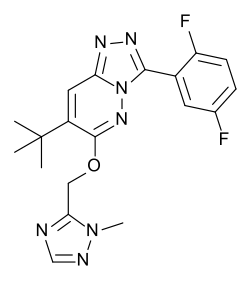L-838,417
L-838,417 is an anxiolytic drug used in scientific research. It has similar effects to benzodiazepine drugs, but is structurally distinct and so is classed as a nonbenzodiazepine anxiolytic. The compound was developed by Merck, Sharp and Dohme.
 | |
 | |
| Identifiers | |
|---|---|
IUPAC name
| |
| CAS Number | |
| PubChem CID | |
| IUPHAR/BPS | |
| ChemSpider | |
| ChEMBL | |
| CompTox Dashboard (EPA) | |
| Chemical and physical data | |
| Formula | C19H19F2N7O |
| Molar mass | 399.397 g/mol g·mol−1 |
| 3D model (JSmol) | |
SMILES
| |
InChI
| |
| | |
L-838,417 is a subtype-selective GABAA positive allosteric modulator, acting as a partial agonist at α2, α3 and α5 subtypes. However, it acts as a negative allosteric modulator at the α1 subtype, and has little affinity for the α4 or α6 subtypes.[1] This gives it selective anxiolytic effects, which are mediated mainly by α2 and α3 subtypes, but with little sedative or amnestic effects as these effects are mediated by α1.[2][3] Some sedation might still be expected due to its activity at the α5 subtype, which can also cause sedation, however no sedative effects were seen in animal studies even at high doses, suggesting that L-838,417 is primarily acting at α2 and α3 subtypes with the α5 subtype of lesser importance.[4][5]
As might be predicted from its binding profile, L-838,417 substitutes for the anxiolytic benzodiazepine chlordiazepoxide in animals, but not for the hypnotic imidazopyridine drug zolpidem.[6][7] The synthesis of L-838,417 and similar compounds was described in 2005 in the Journal of Medicinal Chemistry.[8]
See also
References
- McKernan RM, Rosahl TW, Reynolds DS, et al. (2000). "Sedative but not anxiolytic properties of benzodiazepines are mediated by the GABA(A) receptor alpha1 subtype". Nat. Neurosci. 3 (6): 587–92. doi:10.1038/75761. PMID 10816315.
- Atack JR (2005). "The benzodiazepine binding site of GABA(A) receptors as a target for the development of novel anxiolytics". Expert Opin Investig Drugs. 14 (5): 601–18. doi:10.1517/13543784.14.5.601. PMID 15926867.
- Morris HV, Dawson GR, Reynolds DS, Atack JR, Stephens DN (2006). "Both alpha2 and alpha3 GABAA receptor subtypes mediate the anxiolytic properties of benzodiazepine site ligands in the conditioned emotional response paradigm". Eur. J. Neurosci. 23 (9): 2495–504. doi:10.1111/j.1460-9568.2006.04775.x. PMID 16706856.
- Mathiasen LS, Rodgers RJ, Mirza NR (2007). "Comparative effects of nonselective and subtype-selective gamma-aminobutyric acidA receptor positive modulators in the rat-conditioned emotional response test". Behav Pharmacol. 18 (3): 191–203. doi:10.1097/FBP.0b013e32814fcdd4. PMID 17426483.
- Ujfalussy B, Kiss T, Orbán G, Hoffmann WE, Erdi P, Hajós M (2007). "Pharmacological and computational analysis of alpha-subunit preferential GABA(A) positive allosteric modulators on the rat septo-hippocampal activity". Neuropharmacology. 52 (3): 733–43. doi:10.1016/j.neuropharm.2006.09.022. PMID 17113111.
- Mirza NR, Rodgers RJ, Mathiasen LS (2006). "Comparative cue generalization profiles of L-838, 417, SL651498, zolpidem, CL218,872, ocinaplon, bretazenil, zopiclone, and various benzodiazepines in chlordiazepoxide and zolpidem drug discrimination". J. Pharmacol. Exp. Ther. 316 (3): 1291–9. doi:10.1124/jpet.105.094003. PMID 16339395.
- Mathiasen L, Mirza NR (2005). "A comparison of chlordiazepoxide, bretazenil, L838,417 and zolpidem in a validated mouse Vogel conflict test". Psychopharmacology. 182 (4): 475–84. doi:10.1007/s00213-005-0119-z. PMID 16133136.
- Carling RW, Madin A, Guiblin A, et al. (2005). "7-(1,1-Dimethylethyl)-6-(2-ethyl-2H-1,2,4-triazol-3-ylmethoxy)-3-(2-fluorophenyl)-1,2,4-triazolo[4,3-b]pyridazine: a functionally selective gamma-aminobutyric acid(A) (GABA(A)) alpha2/alpha3-subtype selective agonist that exhibits potent anxiolytic activity but is not sedating in animal models". J. Med. Chem. 48 (23): 7089–92. doi:10.1021/jm058034a. PMID 16279764.